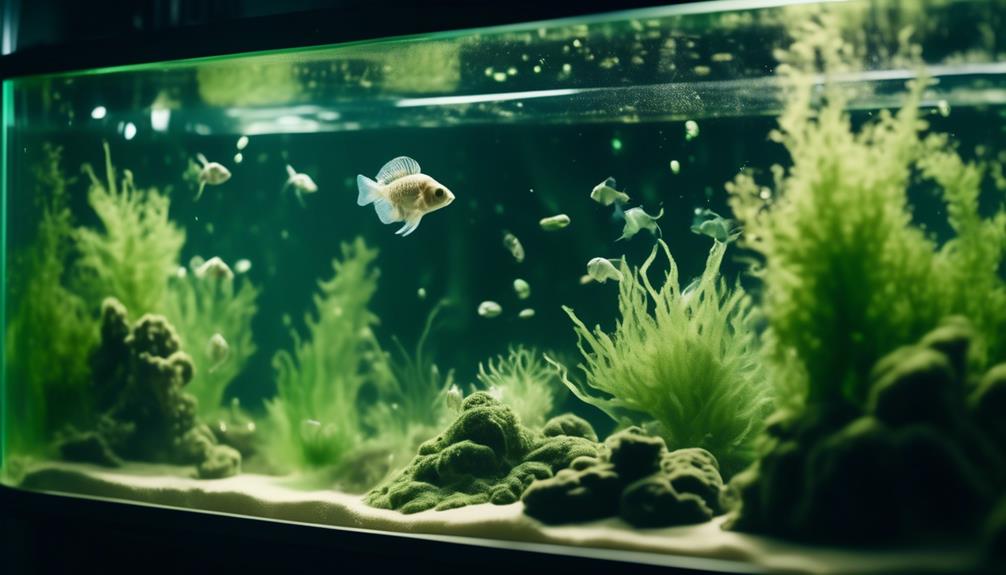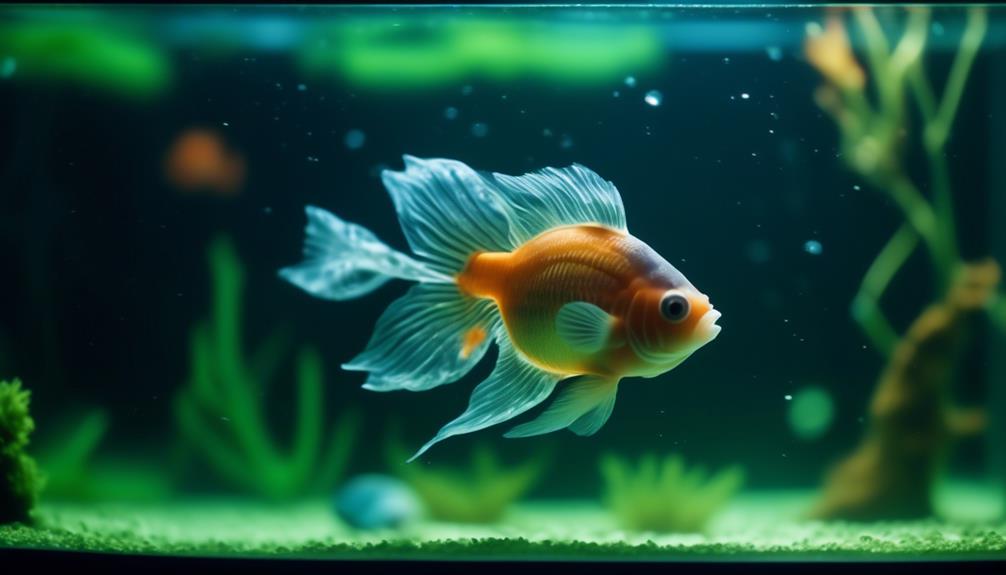Maintaining a pristine fish tank environment can be a challenging task for aquarium hobbyists, particularly when faced with the persistent and stubborn problem of algae growth. While traditional methods of algae control have been widely discussed, a new wave of revolutionary techniques has emerged, offering hope to frustrated fishkeepers.
In this article, we will explore innovative approaches to eradicating stubborn fish tank algae, providing insights into manual algae removal tools and the introduction of algae-eating animals. But that's not all – we will also delve into the importance of removing excess organics, balancing lighting and nutrient levels, and utilizing algae inhibitors.
This comprehensive guide will equip you with the knowledge needed to combat algae growth effectively, ensuring a vibrant and algae-free aquatic oasis.
Key Takeaways
- Manual algae removal tools such as algae scrubbers, Mag-Float cleaners, toothbrushes, and aquarium siphons are effective in removing algae from fish tanks.
- Algae-eating animals like nerite snails, Amano shrimp, otocinclus catfish, bristlenose plecos, and Siamese algae eaters can help control algae growth in fish tanks.
- Removing excess organics like dead leaves, rotting debris, and reducing fish feeding can prevent algae growth in fish tanks.
- Balancing lighting duration, nutrient levels, and considering the use of algae inhibitors like liquid carbon can effectively control and minimize algae growth in fish tanks.
Manual Algae Removal Tools
To effectively combat stubborn fish tank algae, one must employ the use of various manual algae removal tools.
One popular tool is the algae scrubber, a non-toxic melamine foam sponge designed specifically for wiping algae off aquarium walls. This tool is known for its effectiveness in removing algae without harming the tank inhabitants.
Another option is the Mag-Float Glass Cleaner, which utilizes scraper blades to remove tough algae from glass tanks. For acrylic tanks, the Mag-Float Acrylic Cleaner is recommended, along with appropriate scraper blades.
Additionally, a toothbrush can be used to scrub hard-to-reach areas, decorations, hardscape, and plant leaves.
These alternative manual algae removal methods provide aquarium owners with effective solutions to combat stubborn fish tank algae.
Algae-Eating Animals
In the pursuit of combating stubborn fish tank algae, another effective approach involves introducing algae-eating animals to the aquarium ecosystem. These animals can help control algae growth, keeping the tank clean and aesthetically pleasing. They also provide a natural and sustainable solution to the problem, reducing the need for chemical treatments.
When selecting algae eating animals for your fish tank, it is important to consider their compatibility with the existing fish and plants in the tank. Some popular options include nerite snails, amano shrimp, otocinclus catfish, bristlenose plecos, and siamese algae eaters. Each of these animals has its own preferences in terms of tank size, water parameters, and diet, so it is crucial to choose the right ones that will thrive in your specific tank conditions.
Removing Excess Organics

One effective method for combating stubborn fish tank algae is by removing excess organic matter from the aquarium ecosystem. This can be done through various means, including using siphons to remove debris and trimming algae-covered leaves. By regularly performing these tasks, aquarium owners can significantly reduce the presence of organic matter that contributes to algae growth.
Here are four steps to effectively remove excess organics from the fish tank:
- Using siphons to remove debris: Vacuums gravel or sand to eliminate blue-green algae or brown diatom algae that may accumulate in the substrate.
- Trimming algae-covered leaves: In planted tanks, it is essential to trim off dead or algae-covered leaves to prevent the release of excess nutrients into the water.
- Feed fish less: If fish are not consuming all the food within a few minutes, it is advisable to reduce the amount of food given to prevent excess organic waste.
- Improve water flow: By rearranging decorations and filling gaps with substrate, water flow can be enhanced, preventing the formation of dead zones where organic matter tends to accumulate.
Balancing Lighting and Nutrients
Achieving the optimal balance between lighting and nutrient levels is crucial in controlling algae growth in planted fish tanks. Proper lighting and nutrient management are essential to minimizing algae growth and preventing algae outbreaks.
To balance lighting, use an outlet timer to control the duration of light exposure, typically 6-8 hours per day.
Adjust nutrient levels based on nitrate readings, performing water changes if nitrate levels exceed 50 ppm and dosing with Easy Green if nitrate levels fall below 20 ppm.
It is important to wait 2-3 weeks between modifications and observe the impact on plants.
The goal is to minimize algae rather than completely removing it.
Treating With Algae Inhibitors

To effectively control and inhibit the growth of algae in planted fish tanks, it is essential to explore the use of algae inhibitors as a means of addressing the root causes of algae outbreaks. Here are some key points to consider when using algae inhibitors effectively:
- Understand the purpose: Algae inhibitors are designed to prevent and control algae growth, but they are not a cure-all solution. They should be used in conjunction with other algae management techniques.
- Follow dosage instructions: It is important to carefully follow the recommended dosage instructions provided by the manufacturer. Using too little or too much of the inhibitor can be ineffective or harmful to the fish and plants in the tank.
- Use in conjunction with other treatments: Algae inhibitors should be used after balancing lighting and nutrient levels in the tank. Treating algae with inhibitors alone may have little impact without addressing the root causes of algae growth.
- Avoid common mistakes: Some common mistakes when treating algae with inhibitors include using the wrong type of inhibitor for the specific type of algae, not addressing underlying water quality issues, and relying solely on inhibitors without implementing other algae control strategies.
Frequently Asked Questions
Are There Any Natural Methods to Remove Stubborn Fish Tank Algae Without Using Chemicals?
Natural alternatives and DIY remedies can be effective in removing stubborn fish tank algae without using chemicals. Options include manual algae removal tools, algae-eating animals, balancing lighting and nutrients, and treating with algae inhibitors.
Can I Use Algae-Eating Animals as the Sole Method to Control Algae Growth in My Fish Tank?
Using algae-eating animals as the sole method of algae control in a fish tank may be insufficient. Incorporating live plants can help naturally remove stubborn algae. It is important to balance lighting, nutrients, and consider other manual removal tools for effective algae management.
How Often Should I Trim off Dead or Algae-Covered Leaves in My Planted Tank?
The frequency of trimming off dead or algae-covered leaves in a planted tank depends on the extent of algae growth. As an alternative solution, improving water flow, nutrient balance, and lighting duration can help minimize algae growth.
Is It Possible to Completely Eliminate Algae Growth in a Fish Tank?
Eradicating algae growth in a fish tank completely is challenging but possible. Natural methods, such as manual removal tools and algae-eating animals, can help control algae. Chemical treatments should be used as a last resort, after addressing root causes and balancing lighting and nutrients.
What Are the Potential Side Effects of Using Chemical Treatments to Eradicate Fish Tank Algae?
Potential risks of using chemical treatments to eradicate fish tank algae include harm to fish, invertebrates, and beneficial bacteria. Alternatives such as manual removal tools, algae-eating animals, and balancing lighting and nutrients should be considered before resorting to chemical treatments.
Conclusion
In conclusion, by utilizing the innovative methods discussed in this article, fishkeepers can effectively eliminate persistent fish tank algae and maintain a pristine aquatic environment.
Through the use of manual algae removal tools, algae-eating animals, and techniques for removing excess organics and balancing lighting and nutrient levels, fish enthusiasts can overcome the frustrating issue of algae growth.
While chemical treatments should be used sparingly and as a last resort, addressing the root causes of algae growth is essential for long-term success.
